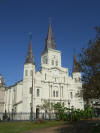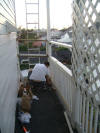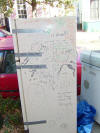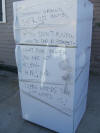The NOLA Report
 Once
again, thanks to all who contributed to my friendship fund! With
your help I was able to assist my friends in buying building
materials, trees and plants for re-landscaping, and some groceries
(necessitated by one especially long, 21 hour power outage).
Once
again, thanks to all who contributed to my friendship fund! With
your help I was able to assist my friends in buying building
materials, trees and plants for re-landscaping, and some groceries
(necessitated by one especially long, 21 hour power outage).
If you’ve never been to New
Orleans and were to visit there now, you would probably just think
it’s a very dirty city—as long as you stayed within the confines
of the popular tourist areas. The visible remnants of hurricane
Katrina has pretty much diminished to blue-tarped roofs and lot of
curbside debris, piled there by returning locals after cleaning
out their water damaged houses, and waiting for pickup by city
garbage trucks.
For me, having been to New
Orleans a number of times, even the ride in from the airport left
me nearly speechless. All sorts of debris littered the grassy areas along either side of
the freeway. An area under the freeway where cars were parked
demonstrated the depth of flooding—starting at the very top,
several waterlines marked the receding waters. Office buildings
along the way were missing signs. Broken windows were boarded up.
At some points you could easily see the downed trees, broken
fences, blue-tarped roofs, and debris-clogged streets of the
neighborhoods.
All sorts of debris littered the grassy areas along either side of
the freeway. An area under the freeway where cars were parked
demonstrated the depth of flooding—starting at the very top,
several waterlines marked the receding waters. Office buildings
along the way were missing signs. Broken windows were boarded up.
At some points you could easily see the downed trees, broken
fences, blue-tarped roofs, and debris-clogged streets of the
neighborhoods.
My friend Ray, who picked me
up, took me into the Marigny/Bywater part of town, entering
through some of the devastated neighborhoods. There were people cleaning out their
homes, hauling the bits and pieces of their ruined
lives to the curb. I had my camera ready, but didn’t have the
heart to take any photos. It just didn’t seem right to intrude on
their heart rending task.
the devastated neighborhoods. There were people cleaning out their
homes, hauling the bits and pieces of their ruined
lives to the curb. I had my camera ready, but didn’t have the
heart to take any photos. It just didn’t seem right to intrude on
their heart rending task.
The most chilling part of my
stay took place after breakfast one day. We’d eaten at
Elizabeth’s, a well known and popular spot in the Bywater—it had
just reopened the week before. Regular patrons were crowding the
eatery, happy to have one bit of normal life back. After leaving,
Ray decided to see if we could get into some of the worst hit
areas, neighborhoods where some of his family lived—or had lived.
There was a National Guard checkpoint, but they were letting
anyone pass through.
Once across the Industrial
Canal, we turned off the main street, onto one of the first side
streets we came to. I was speechless. I have never seen
such concentrated devastation. Trees down everywhere. Water marks
on houses rose above first floor windows. Grassy lawns and shrubs
were dead. Everything was covered with a film of gray mud, left by
the receding waters. In other neighborhoods, the ground was
nothing but caked mud—dried and cracked like a bone dry mudflat.
On many rooftops, we could see the holes chopped through to allow
those living there to escape. One such house was that of my
friend’s aunt.
We drove as close as we could
to the lower 9th Ward—the hardest hit area. There were
still barricades to prevent unauthorized entry, but you could get
fairly close. Even more chilling. It looked like a nuclear winter.
A surreal landscape, something from a movie set. I couldn’t help
but feel…humbled. But humbled isn’t quite the right word. I was
moved by a connection to people I’d never met, would never meet. A
sense of humanity, I think, that binds us when our kind have been
through such an ordeal.
It was an experience I shall
never forget.
 I
stayed in the Marigny, a neighborhood bordering on the French
Quarter. These two areas, the bordering Bywater, and the
Uptown/Garden District were relatively lucky.
I
stayed in the Marigny, a neighborhood bordering on the French
Quarter. These two areas, the bordering Bywater, and the
Uptown/Garden District were relatively lucky.
 They
avoided the devastating flooding that occurred in other parts of
town. But they did suffer a lot of wind damage. Many courtyards,
kept cool by towering oaks and other trees, were obliterated when
the hurricane-force winds uprooted trees and snapped branches like
twigs. The wind also damaged many rooftops, allowing the driving
rain access to interiors.
They
avoided the devastating flooding that occurred in other parts of
town. But they did suffer a lot of wind damage. Many courtyards,
kept cool by towering oaks and other trees, were obliterated when
the hurricane-force winds uprooted trees and snapped branches like
twigs. The wind also damaged many rooftops, allowing the driving
rain access to interiors.
Such was the fate of the
friends I spent most of my time helping. They own a B&B in the
Marigny (www.ladauphine.com)
as well as a condo conversion building nearby. Both properties
suffered extensive wind damage. The courtyard at La Dauphine was filled with trees and
branches from the yards of surrounding
damage. The courtyard at La Dauphine was filled with trees and
branches from the yards of surrounding
 neighbors.
There was some roof damage. At the condos, the large courtyard
there, once surrounded and shaded by large
trees, was a disaster. The building suffered wind damage to one of
the upper balconies and some of the wood siding.
Most of my efforts went into rebuilding fences and the railings on
the balcony at the condos. The last weekend there, my friend Dean,
came down for a few days to help. Between the two of us, we got
the second balcony railing looking good as new—if you don’t look
to awfully close.
neighbors.
There was some roof damage. At the condos, the large courtyard
there, once surrounded and shaded by large
trees, was a disaster. The building suffered wind damage to one of
the upper balconies and some of the wood siding.
Most of my efforts went into rebuilding fences and the railings on
the balcony at the condos. The last weekend there, my friend Dean,
came down for a few days to help. Between the two of us, we got
the second balcony railing looking good as new—if you don’t look
to awfully close.
When I first arrived, in
addition to the debris, curbsides were notable for the tossed out
refrigerators and other
 appliances.
Most were duct taped shut to keep the horrors of rotting and
decomposed, weeks
appliances.
Most were duct taped shut to keep the horrors of rotting and
decomposed, weeks old perishables confined to the interior. Most had been sitting
out for weeks. They started to become a sort of public forum.
People would write on them; announcing the opening of another
restaurant or club or making some political statement. Pickup
eventually began and now you see relatively few of them around—at
least until other residents return and they too go through the
cleaning out process.
old perishables confined to the interior. Most had been sitting
out for weeks. They started to become a sort of public forum.
People would write on them; announcing the opening of another
restaurant or club or making some political statement. Pickup
eventually began and now you see relatively few of them around—at
least until other residents return and they too go through the
cleaning out process.
By the time I left, life for
residents in the “lucky” areas was becoming more and more normal.
They’re really trying to make it so, anyway. There is still no
conversation that doesn’t include talk of Katrina—where one went,
the state of family and property, work, etc. Even in the areas
that are relatively back on line, power outages are frequent. There
were four in our neighborhood
are relatively back on line, power outages are frequent. There
were four in our neighborhood during the two weeks I was there. One lasted 21 hours—prompting
another round of grocery shopping. But people are getting back to
work, going out to cafés and restaurants, doing more than making
pilgrimages to the suburbs to Loews and Home Depot.
during the two weeks I was there. One lasted 21 hours—prompting
another round of grocery shopping. But people are getting back to
work, going out to cafés and restaurants, doing more than making
pilgrimages to the suburbs to Loews and Home Depot.
 There
is still so much devastation the needs to be cleaned up. So many
lives that are not back to normal, and won’t be for a very long
time. But the city is alive! If there’s one thing I want to
impress on people since my return, it’s just that. The New Orleans
that thousands of people around the world know is alive and well!
Let the government and powers that be deal with the task of
rebuilding. What ordinary people can do is return to New Orleans
and spend money there. If you’ve ever been there, the city needs
you back. If you’ve never been there, the city needs you to visit.
You’ll
There
is still so much devastation the needs to be cleaned up. So many
lives that are not back to normal, and won’t be for a very long
time. But the city is alive! If there’s one thing I want to
impress on people since my return, it’s just that. The New Orleans
that thousands of people around the world know is alive and well!
Let the government and powers that be deal with the task of
rebuilding. What ordinary people can do is return to New Orleans
and spend money there. If you’ve ever been there, the city needs
you back. If you’ve never been there, the city needs you to visit.
You’ll find everything you need to keep up-to-date on the city and
all the goings on at
www.nola.com. I’m going back as soon as
I can!
find everything you need to keep up-to-date on the city and
all the goings on at
www.nola.com. I’m going back as soon as
I can!
Schuyler Hoffman
Click Here for More Photos
Contact Us